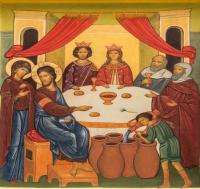
There were probably a large number of people at the Wedding Feast of Cana. Jesus and his twelve disciples would have swelled the number. It would seem at this point that Jesus was still living at home with his mother and taking part in the activities of the region. It is not known exactly where Cana was but it was may have been fairly near Nazareth, and everyone around the area would have been invited. The Middle East is well known for its hospitality, and running out of wine would have been a great disgrace. Mary must have been close to the young couple, as she was aware of the impending catastrophe. She knew that something had to be done and acted promptly as she had when she visited Elizabeth (Luke 1:39-41). However she did not tell her son how to solve the problem; she just put the situation in his hands and told the servants to do whatever he told them.
There are many possible reasons for Jesus being reluctant to take action. One might be that, on a very human level, he had had a very happy life in Nazareth, and once he performed the miracle, things would change dramatically for him. The word “hour” has a deeper meaning here than merely a passage of time. It indicates when he would be glorified through his death and resurrection. John tells us that when this first sign was accomplished, he went with his family and disciples to Capernaum but stayed only a few days (John 2:12). Mary had perhaps given a nudge to her son to begin his public life. It must have been heart-breaking for her. The next time John mentions her, it is when she stood beside the cross, as indeed he came into his glory (John 19:25).